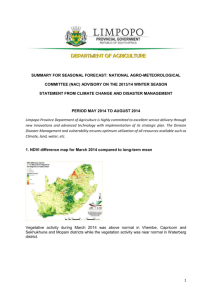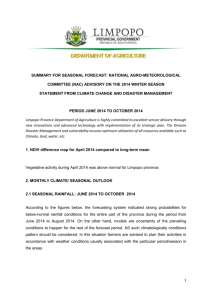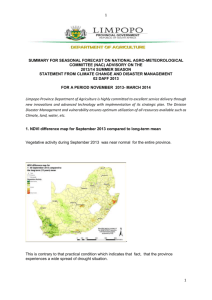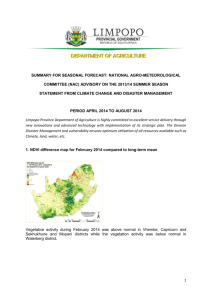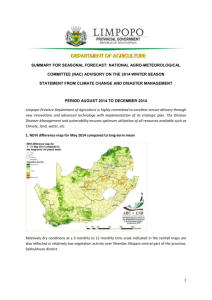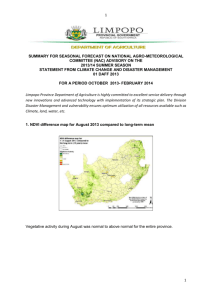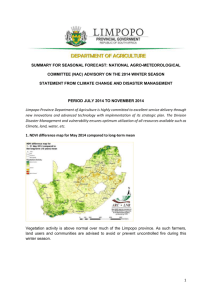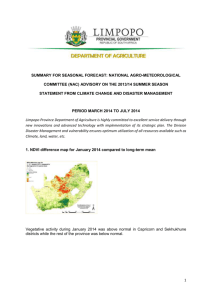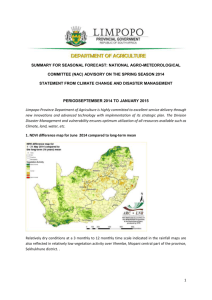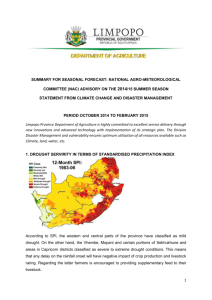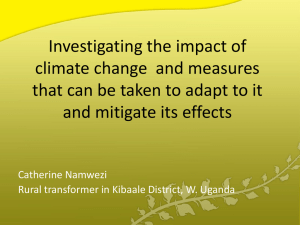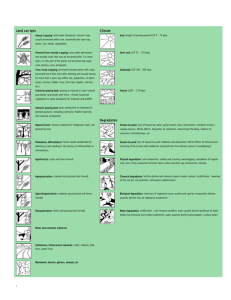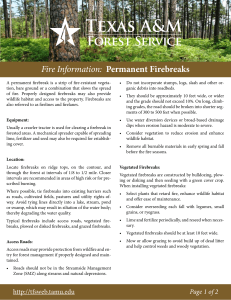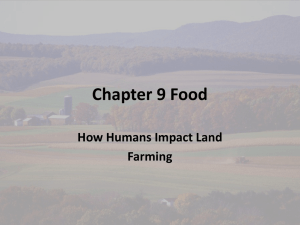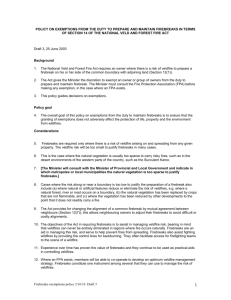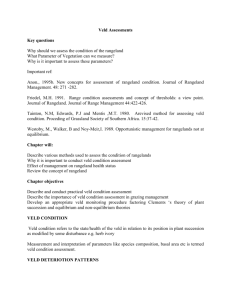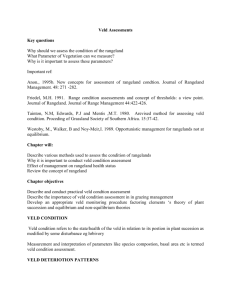Summary for seasonal forecast for the period February 2014 to June
advertisement
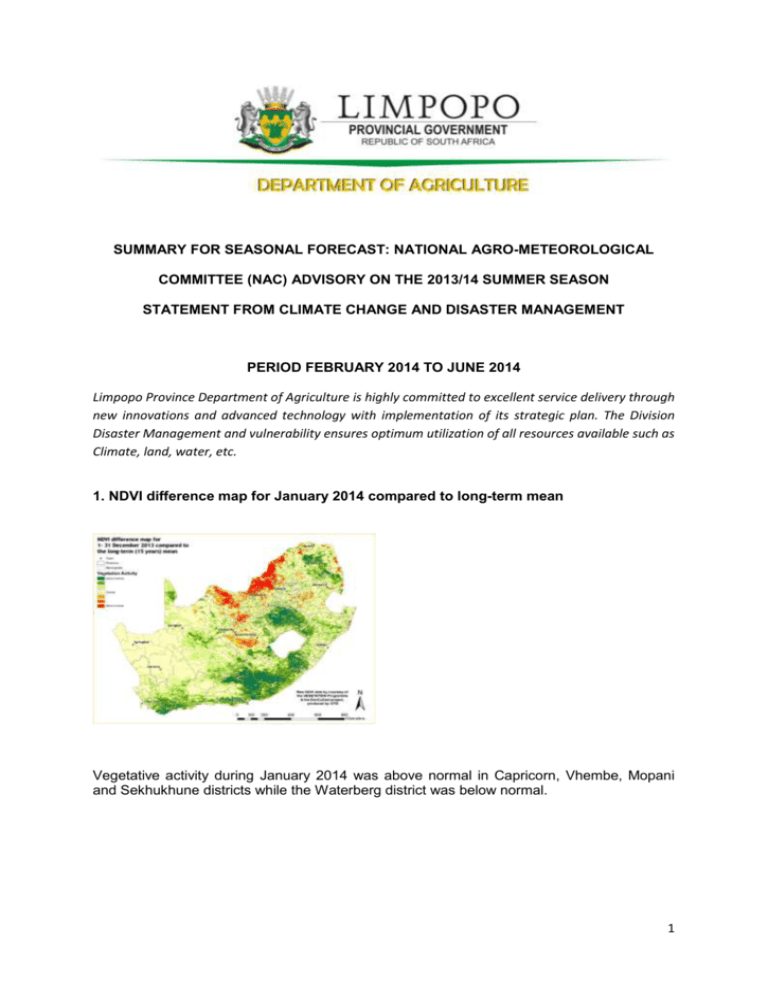
SUMMARY FOR SEASONAL FORECAST: NATIONAL AGRO-METEOROLOGICAL COMMITTEE (NAC) ADVISORY ON THE 2013/14 SUMMER SEASON STATEMENT FROM CLIMATE CHANGE AND DISASTER MANAGEMENT PERIOD FEBRUARY 2014 TO JUNE 2014 Limpopo Province Department of Agriculture is highly committed to excellent service delivery through new innovations and advanced technology with implementation of its strategic plan. The Division Disaster Management and vulnerability ensures optimum utilization of all resources available such as Climate, land, water, etc. 1. NDVI difference map for January 2014 compared to long-term mean Vegetative activity during January 2014 was above normal in Capricorn, Vhembe, Mopani and Sekhukhune districts while the Waterberg district was below normal. 1 2. MONTHLY CLIMATE/ SEASONAL OUTLOOK 2.1 SEASONAL RAINFALL: FEBRUARY 2014 TO JUNE 2014 Total Rainfall probabilities for February 2014- July 2014: The models are uncertainty of the prevailing conditions to happen. AS such climatologically condition pattern should be considered. In this situation farmers are advised to plan their activities in accordance with weather conditions usually associated with the particular period/season in the areas. 2.2 SEASONAL TEMPERATURE FORECAST: FEBRUARY 2014 TO JUNE 2014 2 The models are uncertainty of the prevailing situation for the first part of the season. It is therefore imperative for the use to consider the climatologically condition for the area in to account when making any decision. However, there is higher probability that the mean maximum temperatures are expected to be below normal for the period May 2014- July 2014 In the light of the above seasonal outlook the following advisory guidelines are suggested. It is emphasised that these advisories are broad guidelines and should be interpreted considering the local aspects of the region such as soil types, cultural preferences and farming systems. The basic strategy to follow would be to minimize and diversify risk, optimize soil water availability and to manage the renewable resources (rain water and grazing) to uphold sound farming objectives. The districts/ municipalities should further simplify, downscale and package the information according to their language preference and if possible use local radio stations and farmers’ days in disseminating the information. 3. SUGGESTED STRATEGIES A. Rain-fed crop production (Winter Crop) Soil choice: Choose suitable soil type. 3 Roughen the soil surface to minimize evaporation. Minimise compaction by reducing the passing of heavy machinery in the field. Land preparation: Minimum or zero tillage is encouraged to minimise green house gases emission. Use a ripper to break plough pans and increase access of roots to stored water and nutrients. Prioritise fallow land. Crop choice and planting: Choose suitable cultivars as a precautionary measure. Provide flexibility and diversification. Stick to normal planting window if appropriate and follow the weather and climate forecast regularly. Consider staggered planting-spreading over weeks. Always practice crop rotation. Lay out planting rows parallel to the prevailing direction of the cold air flow. Keep air drainage pathways open to insure good air drainage and elimination of frost pockets. Crop management: Adjust planting density accordingly. Consider mulching to minimise evaporation. Always eradicate weeds. Consider a conservative fertilizing strategy during dry conditions. Consider organic fertilization. Prune trees properly to avoid blocking air movement. The removal of low hanging, dense branches is a must. Using white paint on trunks of peaches and other tree fruits reduces winter trunk damage. Use overhead sprinkler irrigation. Consider mulching to minimize evaporation. Control weeds regularly. Scout for pests and diseases regularly and control where necessary. 4 B. Irrigation farming Remove all weeds containing seeds, but keep other vegetative rests on the land because that will reduce evaporation. Check and repair all tools and machinery. Irrigate during cool conditions to avoid evapotranspiration. Consider using drip irrigation as it saves water by allowing it to drip slowly straight to the roots. Avoid over irrigation because that can create problems e.g. water logging and diseases. Adhere to the water restrictions when issued. C. Domestic and home garden water use Conserve existing water supplies. Eradicate water weeds. Limit water waste and losses. Repair leaking pipes. Re-use water and retain high quality. Harvest water during rainy days. D. Livestock farming (very important) For most of the country, if the correct farming practices have been followed and stocking rates have been kept in balance with carrying capacity, animals should be in relatively good condition. Never exceed carrying capacity of plant associations and densities – keep conservative stocking rates even during favourable climate conditions. Provide lots of drinking points. Enhance nutritional value of dry grazing/feed with licks: o Licks should (in most cases) provide: - Phosphorous. - Urea (to help with the break-down of dry vegetation). - Salt. 5 - Molasses. o Deficiencies differ according to vegetation composition/soil properties/climate. o Analysis of vegetation/soil samples can benefit the decision for supplement composition. - Sell mature, marketable animals (to help prevent overstocking). - If grazing is in danger, herd animals into pens where different animals can be segregated and fed separately. E. Grazing Management. (Very important) Subdivide your grazing area into camps of homogeneous units (in terms of species composition, slope, aspect, rainfall, temperature, soil and other factors) to minimise area selective grazing as well as to provide for the application of animal management and veld management practises such as resting and burning. - Determine the carrying capacity of different plant associations. - Calculate the stocking rate of each, and then decide the best ratios of large and small animals, and of grazers or browsers. - Provide periodic full growing-season rests (in certain grazing areas) to allow veld vigour recovery in order to maintain veld productivity at a high level as well as to maintain the vigour of the preferred species. - Do not overstock at any time to avoid overgrazing. - Eradicate invader plants. - Periodically reassess the grazing and feed available for the next few months, and start planning in advance. - Spread water points evenly. F. Veld fires The districts, municipalities and farmers are advised to ensure that firebreaks are in place especially in winter rainfall areas where fuel load is high and may exacerbate the spread of fires. An owner of the land who is obliged to prepare and maintain a firebreak must ensure that, with due regard to the weather, climate, terrain and vegetation of the area, the following is taken care of in terms of installing firebreaks (Chapter 4 of National Veld and Forest Fire Act No. 101 of 1998): It has to be wide enough and long enough to have a reasonable chance of preventing a veld fire from spreading to or from neighbouring land. 6 It does not cause soil erosion and It is reasonably free of inflammable material capable of carrying a veld fire across it. Firebreaks may be temporary or permanent. Firebreaks should consist of fire-resistant vegetation, inflammable materials, bare ground or a combination of these. Firebreaks must be located in such a way as to minimize risk to the resources being protected. Erosion control measures must be installed at the firebreak. Maintaining firebreaks: Mow, disk, or graze vegetative firebreaks to avoid a build-up of excess litter and to control weeds. Inspect all firebreaks for woody materials. Inspect firebreaks at least annually and rework bare ground firebreaks as necessary. Repair erosion control measures as necessary. Access by vehicles or people must also be controlled. Bare ground firebreaks, which are no longer needed, must be stabilized i.e. Sow grass. Mulch. What to do when conditions favourable for veldfire are forecast: Prohibit fires in the open air during periods of high fire hazard and establish a fire control committee. To control fires, an alarm system, fire-fighting teams, and beaters must be organized in advance and plans prepared. Livestock should be moved out of grazing land to a safe place. What to do during veldfire: Water is generally not available in sufficient quantities or at adequate pressure for the control of major fires; however, sand or other loose mineral soil material can be an effective method of control. Tree branches can be used to beat fire. 7 G. Heat stress – bad for productivity (very important) Signs of heat stress: Bunching in shade, high respiratory rates, open mouth breathing. What to do: Offer shade. Offer water- keep good quality water in front of animals. Wet with sprinklers/fire hose. Water ground. Avoid overworking animals. Control insects. Biting insects, such as flies can further stress livestock and interrupt their cooling. If pastures or buildings draw insects to livestock during times of extreme heat, provide proper insecticides or considering relocating your livestock. Poultry Provide cool, clean, quality drinking water to your poultry. Water will help keep your birds cool. Always make sure your poultry is in a well-ventilated area in which there is nothing to obstruct the airflow. Provide feed during the coolest part of the day. Supplement drinking water with electrolytes. Reduce the number of birds kept in a house or in an area. Avoid excessive activity during the hottest part of the day. H. Severe thunderstorms/flash floods Building resilience Identify resources/facilities within 50 km that can be utilized and can be of help during emergencies. Be sure to have legal and adequate markings to identify your livestock. Stay well informed about livestock in your possession and conduct an inventory after the event. Monitor television and local radio stations for information regarding severe storms/flash floods in your region. Identify natural or built areas/shelters where animals can be kept during such conditions Sufficient height to be above water level, Sheltered from strong winds and wetness, 8 Restrict access to high-risk areas such as low lying fields close to streams. Store food in safe areas sheltered from wetness to be used after storms/flash floods. Keep pesticides and other chemicals in areas where water will not be contaminated during extreme rainfall/storm events. Inspect/repair farm dams Before rainy season, after each event. The climate advisory should be disseminated widely. Users are advised to be on the look-out and act on the extreme daily warnings as well as the advisory update next month. Information sharing groups are encouraged especially among farming communities for sustainable development. It is the responsibility of farmers to implement disaster risk measures. The Disaster Management Act (Act No. 57 of 2002) urges individuals and farmers, to assess and prevent or reduce the risk of disasters using early warning information. For more information contact Provincial Disaster Risk Management and Vulnerability Mr Mbere Munzhelele @ 082 263 2088. Mrs Mashamaite MD @ 082 802 4760 DAFF, Directorate: Climate Change and Disaster Management Private Bag X250 Pretoria 0001 Tel:012 319 7955/56; Fax: 012 319 6711 Email: PA.DADRM@daff.gov.za SAWS: Private Bag X097 Pretoria 0001 Tel: +27 (0) 12 367 6000 Fax: +27 (0) 12 367 6200 http://www.weathersa.co.za ARC Institute For Soil, Climate And Water Private Bag X79 Pretoria 0001 Tel: 012 310 2500 Fax: 012 323 1157 Email: iscwinfo@arc.agric.za http://www.arc.agric.za 9
